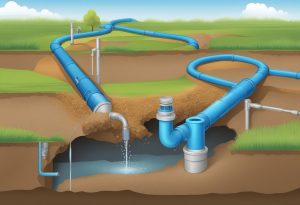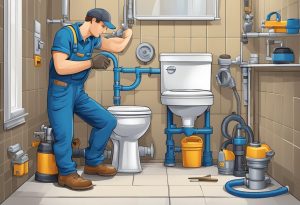Overview
Detecting concealed pipe leaks is a crucial aspect of maintaining a plumbing system. Not only do these leaks contribute to water loss, but they can also lead to structural damage and corrosion if left untreated. Numerous leak detection methods exist, each with its pros and cons in terms of accuracy, cost, and feasibility.
Several technologies are employed for detecting leaks in concealed pipes. These include:
- Acoustic Detection: Utilizing hydrophones, geophones, or accelerometers to capture sound waves produced by leaks. Acoustic leak detection is popular due to its non-invasive nature and accuracy.
- Mass Balance: Monitoring water meters to track discrepancies in water usage and identify potential leaks. This method requires continuous monitoring and efficient data analysis.
- Optical Sensors: Fiber optic sensor systems identify leaks through changes in light transmission caused by water intrusion.
Machine Learning and Artificial Intelligence
In recent years, machine learning techniques have played an increasingly important role in concealed pipe leak detection. Methods such as artificial neural networks, genetic algorithms, and fuzzy systems can improve the accuracy and efficiency of leak identification and localization. These technologies help streamline the detection process and enable prompt maintenance.
Selecting the Right Method
The choice of leak detection method depends on various factors, such as the type of pipe material, the environment, and budget constraints. It is essential to evaluate each method’s effectiveness for a particular plumbing configuration to achieve optimal results.
In conclusion, concealed pipe leak detection is a critical aspect of plumbing maintenance, employing an array of technologies and methodologies. Through continuous innovation and development, these methods continue to improve in terms of accuracy, localization, and cost-effectiveness
Frequently Asked Questions
How does ultrasonic technology help in detecting pipe leaks?
Ultrasonic technology is widely used in detecting pipe leaks due to its non-invasive approach and high accuracy. It works by emitting high-frequency sound waves that travel through the pipe walls or the surrounding area. When the waves encounter a leak, their amplitude and frequency change, reflecting the presence of a leak. Signal processing equipment analyzes these changes, allowing technicians to pinpoint the exact location of the leak.
What is the role of thermal imaging in finding hidden water leaks?
Thermal imaging plays a crucial role in locating hidden water leaks because it allows for non-intrusive, quick, and precise leak detection. Technicians use infrared cameras to record the differences in temperature between water-filled areas and dry areas. As water escapes and causes a temperature anomaly, the infrared camera captures and displays it, helping technicians identify and locate the leak.
Can ground-penetrating radar detect underground pipe leakages?
Yes, ground-penetrating radar (GPR) can effectively identify underground pipe leakages. GPR uses electromagnetic waves that penetrate the ground to detect changes in the sub-surface structure. When a leak occurs, the soil or material around the pipe becomes saturated with water, altering the electrical properties. GPR helps detect these changes, thus identifying the location of underground pipe leakages.
How is sonar imaging utilized by plumbers for detecting leaks?
Sonar imaging, also known as acoustic leak detection, is a technique used by plumbers for detecting leaks in pipes. This method relies on sensitive microphones and amplifiers to pick up sound waves generated by water escaping from the leak. By analyzing and triangulating these sounds, technicians can accurately locate leaks, even in underground or concealed pipes.
What are the available methods for detecting leaks in underground pipelines?
There are several methods available for detecting leaks in underground pipelines, including:
- Ultrasonic leak detection
- Thermal imaging
- Ground-penetrating radar
- Acoustic detection (sonar imaging)
- Tracer gas detection
- Video or CCTV inspection
Each method has its advantages and limitations, and the choice of technique depends on factors such as pipeline material, location, and leak size.
How should one interpret data from ground-penetrating radar for leak detection purposes?
Interpreting data from ground-penetrating radar for leak detection requires a thorough understanding of the radar principles and the specific characteristics of the subsurface being studied as well as training in signal processing. GPR data is usually displayed as a series of line scans or cross-sectional images showing the location of various materials, such as soil, water, or pipes. By identifying zones with higher electrical conductivity or changes in underground materials, technicians can deduce possible leakage locations and focus their attention on those areas for further investigation.
Seven Engineering and Professional Services: Advancing Global Expertise in Innovative and Inclusive Technology
In the rapidly evolving landscape of engineering and professional services, we see an undeniable trend towards leveraging advanced technology to empower experts around the globe.
Water Leakages Detected Malaysia: Nationwide Solutions and Prevention Strategies
Underground Water Leak Detection: Vital Approaches for Early Identification Key Insights Underground water leak detection is crucial for preventing water wastage and damage to infrastructure.

How are underground water leaks detected?
Underground Water Leak Detection: Essential Strategies for Early Discovery Underground water leaks are a pervasive issue that can lead to significant water wastage and financial

Concealed Pipe Leak Detection Method: Efficient Solutions for Hidden Problems
Overview Detecting concealed pipe leaks is a crucial aspect of maintaining a plumbing system. Not only do these leaks contribute to water loss, but they can also

Toilet Repair: Essential Tips for Fixing Common Issues
Toilet repair is an essential aspect of home maintenance, as a properly functioning toilet is crucial for the comfort and hygiene of any household. Common

Plumbing Inspections Kuala Lumpur: Your Guide to Expert Services
When considering the purchase of a property in Kuala Lumpur, securing a plumbing inspection is a smart move that goes beyond just checking off a box. It’s
SEVEN ENGINEERING (BERLIN) GLOBAL TECH BHD
SEVEN ENGINEERING (BERLIN) INNOVATION DESIGN & SERVICES SDN BHD

